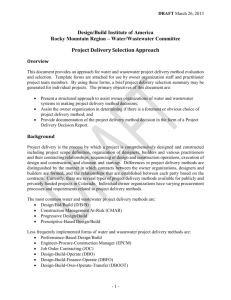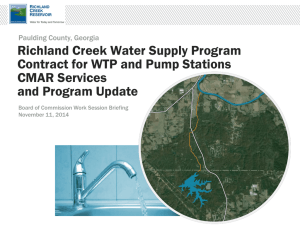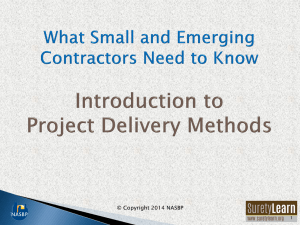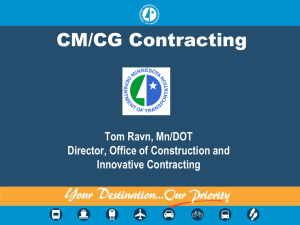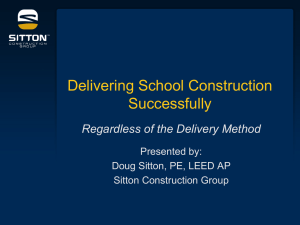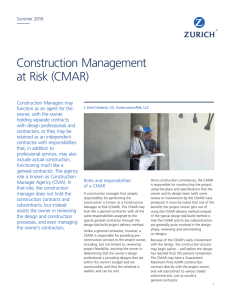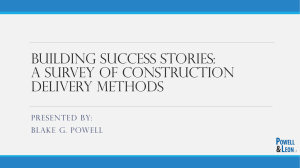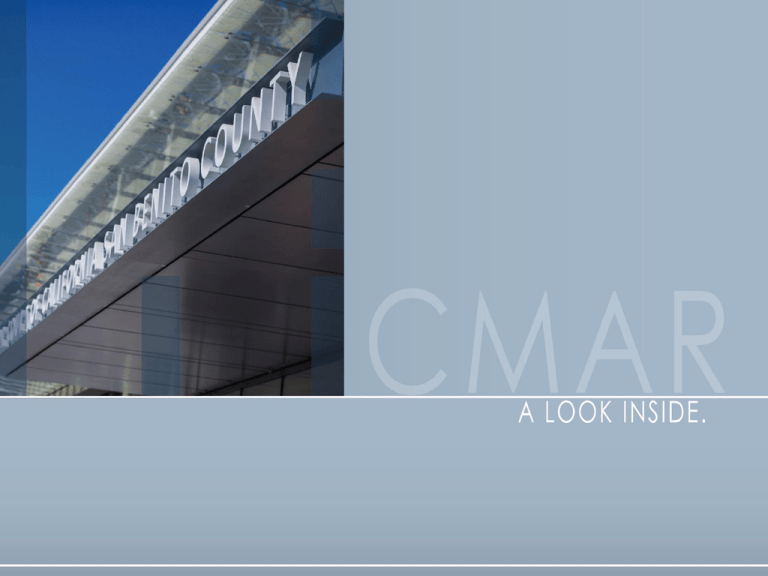
Kenneth J. Harms
Vice President
Kitchell, CEM
Rona G. Rothenberg, FAIA,
LEED Green Associate
Senior Manager, Design & Construction Services,
Judicial Branch Capital Program Office
Judicial Council of California-Administrative
Office of the Courts
Would you accept this deal?
Design a 103 story office building in 2
weeks
Build a $500M project in less than 14
months
CMAR has Been
Around for a Very Long time!
• Built in 1930 for $41M
($8M below budget) in 13
½ months
• $500M in today’s dollars
State and County Authority
SB 1732 – Trial Court Facilities Act of 2002
established the judicial branch authority for
facilities, including funding and exemption
from the Public Contract Code (PPC)
SB 328 (2013) extends CMAR as a project
delivery method to all. (Government Code
Section 20146)
“
Construction management at-risk is seen by
many policy-makers and legislators as an
innovative approach to public sector project
delivery. The CM at risk delivery method is an
alternative procurement process similar to
long-standing private sector construction
contracting. CM at-risk is a cost effective and
time conscious alternative to the traditional
design-bid-build process.
-AIA Washington DC, 2005
”
“
A project delivery method is fundamentally a
people method because people remain the
most valuable construction resource. The
success or failure of any delivery method
depends upon the performance, trust, and
cooperation among the parties.
-AGC, Project Delivery Methods for Construction, 2011
”
CMAR
Not Using
Under Consideration
CMAR Public
Owners in California
23 Locations
10 locations
58 Locations
CM at Risk Philosophy
OWNER
• Respect the role &
responsibility of each team
member
• Develop trust & confidence
based on performance
Collaborative
Team
Approach
A/E
• Exceed expectations
CM
Organization
Procurement and contract structure functional much like a
private sector model of the negotiated contract.
Criteria for selection are qualifications based and include
competitive bid with preconstruction services. Criteria for
selection of the CMAR vary from one jurisdiction to another based
on allowable and measurable factors.
In Preconstruction services, the contractor works slid-by-side with
architect and owner in the design phase to analyze and select
materials equipment based on cost, benefits and availability
CM at Risk vs. DBB/Lump Sum
Designer Involvement
CM at Risk
Low Bid
Contractor involvement in Design Phase
√
No
Owner receives competitive pricing
√
√
Performance and payment Bonds
√
√
Ability to Re-bid individual trades
√
No
Prequalify all subcontractors
√
No
Field coordination control
√
√
Commissioning/ Warranty Issues
√
√
Price Guarantee
√
√*
Contractor pays for scope gaps
√
√
Contractor contingency available for E&O
and unanticipated field conditions
√
No
*Low bid not always final price
California SB 1732
Trial Court Facilities Act of 2002
California Code of Regulations
Government Code Sections 69202 et seq.
Establishes statutory authority for the State of
California Judicial Branch responsibility for
court facilities including initial funding source
Section 70374 provides an exemption from the
Public Contracts Code, subject to appropriate
contracting policies and procedures
Trail Court Facilities Program
2002 - Present
Court projects: 46 authorized since 2004
Courtrooms: 1 to 71
Sizes: 6,500 – 704,000 bgsf
Project Cost: $3M – $634M
Estimated Total:$5.5B
Funding: Cash, lease revenue bonds
Project Status in 2014:
– 14 Completed
– 12 in construction
– 20 in design or site acquisition
California Judicial Branch Capital
Program
Court Facilities Contracting Policies and
Procedures, Adopted by the Judicial Council of
California on 12/7/07 established multiple
construction delivery methods, procedures for
procurements of goods and services
Judicial Branch Contracting Manual, CA PCC
Sections 9201-19210, became effective
10/1/2011 as an overriding contracting code
with certain exemptions pertaining to capital
facilities projects
CM at Risk Comparison
Best Suited
Larger new or renovation
projects
In general projects greater
than $7M
Least
Suited
Smaller projects
CM at Risk Lessons for Success
• Owner involvement essential
• Need clear definition of CM & A/E’s roles
• Determines preferences for “Agency” vs. “At-Risk”
contracts
• Inform and educate your staff and superiors
• Establish County internal processes to support
CMAR
• Establish a fundamental attitude toward a
collaborative or advocacy approach to the “openbook” type of contract administration, nonadversarial with a spirit of trust about scope, cost
and time
Benefits to the Owner
Owner chooses their builder on QBS
Project team works in a collaborative atmosphere
Greater schedule control/ flexibility
Greater budget control including re-bid on individual
trades if necessary
Pre-qualify all trade contractors
Minimum three bids in each trade
Owner & Architect can participate in sub selection
Lowers potential for future change orders
Perceived as more friendly contracting approach by
designers and subcontractors
“Open Book” financial approach
Benefits to the Architect
A/E maintains contractual relationship to
Owner
Selection of contractor based on
qualifications
Contract involvement during design phase
GMP prior to construction
Benefits to CMAR Firm
Selected on Best Value not Low Price
Involved in Design Phase
Collaboration vs. Confrontation
Prequalification of Major Trades
Manageable Risk
Known Site Conditions
Quality of Documents
CMAR Selection Process
CM at Risk Selection Process: RFQ
Recommended Information
Basic Company Data
•
•
•
•
•
•
Firm History
Local Office
Primary Contact
Licensing Information
Form of Ownership
Designer/County Internal Processes to Support
CMAR
CM at Risk Selection Process: RFQ’s
Recommended Information
Insurance Requirements
• Limits of Coverage
• Company Rating
• Completeness of Coverage
Bonding Capacity
• Single Project Limit
• Aggregate
• Letter from Agent
CM at Risk Selection Process: RFQ’s
Recommended Information
Safety Program
• EMR
• Safety Plan
• Training
Quality Program
Management Information Systems and
Technology
CM at Risk Selection Process: RFQ’s
Recommended Information
Personnel Capability
Consultants
Experience in Delivery System and Project
Type
Safety Record
Financial Information
References
CM at Risk Selection Process: RFQ’s
Recommended Information
Detailed Information on Select Relevant Project
Information- at least 3 similar
Team
• Organization Chart
• Resumes
• % of Time Commitment
Management Plan
• Approach to Managing the Project
-Phasing, Bid Package Strategy, Site Logistics
• Schedule
CM at Risk Selection Process:
Discussion/Interviews
Provide for Adequate Time
• 45 to 60 Minutes for Technical Presentation
• 15 to 30 Minutes for Questions & Answers
Objective and Interested Selection
Committee
Well Defined Selection Criteria and Scoring
Information- Share It!
AOC Criteria for Contractor Selection and
Short List, CMAR and Prequalified GC
Written SOQ’s which respond to specific
requirements of the RFQ
SOQ’s ranked based on published criteria
Evaluations done by the PMS with
Procurement team and Court, with architect
as advisory
All submissions must be in on time!
Criteria for Contractor Selection
Criteria for Selection per RFQ:
Financial Strength
• 20 points
Demonstrated Experience of firm
• 30 points
Demonstrated Experience and training of personnel
• 30 points
Project Plan including
• 20 points
Local Outreach Plan
• 5 points
Total scoring 100 points
AOC Contractor Selection Process
CMAR Selection and Prequalified GC
Separate evaluation of RFQ and Interview per RFQ
Criteria by point scoring
CMAR Selection
Sealed fee (including total of preconstruction services
and fee based on direct cost of work) opened:
$ Total price in dollars = Cost Per Unit of Quality
Total quality points of Quality
Lowest Cost per Unit of Quality is responsive
CMAR Services
CM at Risk Design Phase Services
Management Plan
Budget Estimates
Value Engineering
Constructability Review
Bid Package Strategy
Master Schedule
Construction Schedule
Logistics Planning
CM at Risk Bid Process
Pre-Qualify Subcontractors
Advertise to Bid
Invitation/ Instructions to Bidders
Scope of Work Sheets
Pre-Bid Meeting
Public Bid Opening
Evaluate Bids
Owner Assigns Bids to CM at Risk
What is a GMP
A Guaranteed Maximum Price (GMP) is the
amount that the CM at Risk firm guarantees
(the sum of the cost of the work and the CM’s
fee) it will not exceed. The maximum is subject
to additions and deductions, due to changes in
the scope of work. All costs which exceed the
GMP and are not approved by change order
are paid by the CM.
CM at Risk-Preparation of the
Preliminary GMP
Total Direct Cost of Work
CMAR Fee
CMAR GC’s
Project Contingency
Allowances
Total GMP
$
$
$
$
$
$
Terms and Requirements which
Affect the GMP
• DVBE, MBE and related goals or requirements
• OCIP or CCIP
• Self Performance and terms of procurement
• Labor agreements
• Local outreach goals or requirements
• Subcontractor listing
• Deductive and additive alternates
• Terms for administration of the retention
CM at Risk - GMP
CM at Risk Cost
(GC’s + Fee + Precon Cost)
+
Subcontractors Bids
= GMP
+
Contingency
(3% controlled by CM)
Changes to the GMP
Errors & Omissions
Change of Scope
Unforeseen Conditions
Including Force Majaeur
CM at Risk Services
Construction Phase
Field Management
Safety Program
Field Engineering
Quality Control Program
Field inspection Administration
Commissioning Services
Project Close Out Process
Warranty Period Service
Construction Phase
Construction of building and
site features
Furniture installation
Quality Assurance
– Inspections
– Site visits by A&E and AOC OCCM
Team
Commissioning of building
systems
Occupancy
Court responsible for telephone
and data equipment and servers
Court responsible for staff move-in
AOC post occupancy evaluation
– Survey building users
– Lessons learned
LEED “Silver” certification by the
United States Green Building
Council
New Hollister Courthouse
Superior Court of San Benito County
Status: Bid Phase Construction Cost: $34M Architect:
SmithGroup Contractor: Kitchell (CM@Risk)
Lessons Learned from AOC in CMAR
Careful consideration of qualifications
Meticulous checking of references and
background
Unimpeachable qualification of low bids
Establish a basis to evaluate the
preconstruction services as a condition for
the construction contract
Watch out for the “lump sum low bid in
disguise” delivered by some CMAR’s
Lessons Learned from CM’s
When is GMP Established?
Establishing the GC’s as a baseline
allowance in the initial fee proposal
Ownership of Design Errors/ Omissions
Shared Savings Clauses
Contingency Ownership
Self-Perform Work – Yes or No?
Contract Key Features CMAR
Scope of work in preconstruction
Contractual obligation for the content of the architects’
documents
Appropriate development of bid packages and
prequalification of the subs
Administration of the contractor’s contingency
Administration of the GMAX as an open book process
Re-qualification of the GC’s, consideration of
supplemental conditions if needed
Proper field staffing and administration of field
documentation
What’s Important to AOC
Compliance with design standards which
anticipate well-designed, well-constructed
buildings that consider long-term ownership
costs and needs
Strong partnerships with our architects and
contractors which are collaborative advocacies
Good service by you to us and the Courts
That you succeed and are profitable in giving
us these things
CMAR Projects in California
Cal Berkeley Memorial Stadium
Fresno State Library
Fullerton State Steven Mihaylo Hall
Cal Poly Recreation Center
Jacobs Medical Center
AOC, Hollister Courthouse
Marian Medical Center
Cal Poly Recreation Center
Questions & Answers
SUMMARY
For more information:
Rona G. Rothenberg, FAIA, LEED Green Associate Senior Manager, Design and Construction Services
Judicial Branch Capital Program Office Judicial and Court Operations Services Division Judicial Council of
California-Administrative Office of the Courts
455 Golden Gate Avenue
San Francisco, CA 94102-3688
Phone 415-865-4063, Mobile 415-305-2566, Fax 415-865-8885 rona.rothenberg@jud.ca.gov
www.courts.ca.gov
Contact
Kenneth J. Harms
Vice President
2750 Gateway Oaks Drive, Suite 300
Sacramento, CA 95833
O: 916.648.9700/ C: 916.956.4059
Follow us: Facebook | Twitter | LinkedIn |
KitchellProgress.com
For Information
Judicial Branch Building Program
www.courts.ca.gov/programs-facilities.htm
Thank you!

